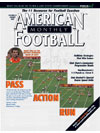AMERICAN FOOTBALL MONTHLY THE #1 RESOURCE FOR FOOTBALL COACHES
Article CategoriesAFM Magazine
|
The Strength Report: Developing the Explosive Athlete - Linebackersby: Jon FrancisDir. of Strength and Conditioning, San Diego State University © More from this issue First and foremost our program is about producing results. Coaches can design the greatest programs on paper, but if athletes are not committed to the program then they are simply pieces of paper. Ground based and multi-joint exercises support the foundation of what we teach and coach. We use squatting, various single leg and hamstring exercises to gain strength in the hips and lower body. It is imperative that the top of the thighs be parallel during a squat – a shallow squat is not as effective as a parallel or deep squat. Due to the nature of football, power oriented and effort driven movements are essential to maximizing the potential of our athletes. Our athletes achieve power output in a myriad of avenues. We utilize Olympic lifts and plyometrics to develop powerful, explosive, flexible hips. However, if these movements ar....The full article can only be seen by subscribers. Subscribe today!
|
|
|||||||
| HOME |
MAGAZINE |
SUBSCRIBE | ONLINE COLUMNISTS | COACHING VIDEOS |
Copyright 2025, AmericanFootballMonthly.com
All Rights Reserved





